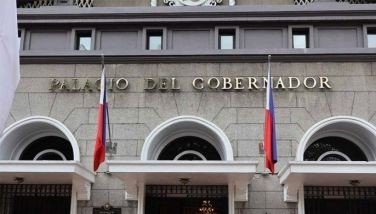Air Force seeks additional budget for modernization program
June 2, 2005 | 12:00am
The Philippine Air Force (PAF) needs more than just ingenuity to keep its aircraft safe and flying.
The PAF yesterday asked the government for additional funds amid criticisms of its performance and a recent series of helicopter crashes.
"Definitely, modernization will need additional funding. There is no funding to buy new equipment. Definitely there is a need for funding the modernization program," PAF Public Information Office chief Maj. Augusto de la Peña said.
The PAF’s budget can only cover the cost of operations for 120 aircraft, with an average of operational readiness rate of 85 percent, De la Peña said.
He said the PAF budget allocation for 2005 is only P6.7 billion and two-thirds of that was earmarked for the salaries of the PAF’s 14,000 personnel.
Some P2 billion will go to maintenance and other operating expenses (MOOE), such as aircraft fuel.
"Normally, we fly 25,000 to 30,000 flying hours," he said. "With the current budget, we can only fly around 15,000 flying hours. We need additional allocation to fly the remaining 10,000 flying hours to complete the 25,000 flying hours."
Dela Peña said the low PAF budget reduces the number of aircraft the PAF can operate and the number of hours it can fly.
The effect of the low PAF budget on aircraft safety is felt in terms of maintenance, he added, saying that older aircraft are harder and more costly to maintain and have higher operating costs.
Cannibalism of aircraft is a common practice of most aircraft fleet operators, he said. "Normally we stock aircraft spare parts, but we cannot stock everything — especially if you have a limited budget," De la Peña said.
"If one aircraft needs a spare part, in the process of procuring while waiting, we get (that part) from another aircraft," he said. "That is called controlled transfer. Each part is tracked."
"It’s quite alarming that we had this spate of accidents. Starting off with the April 28 crash of the UH-1H (helicopter), followed by three more civilian light aircraft, then the Cessna training aircraft," he said. "Just a couple of days ago, another light aircraft, a Bonanza, (crashed) in Palawan."
Despite the dearth of spare parts and high operating expenses generated by older aircraft, the PAF has a robust safety program in terms of procedure and manpower, De la Peña said.
The PAF has a command level Air Force Safety Office (AFSO), he added. At wing level, they provide Wing Safety Officers, down to the squadron level.
He said safety consciousness is inculcated in all PAF aircraft operators.
"It is difficult to anticipate all the events, (and there is) difficulty in controlling the environment," De la Peña admitted. "The best thing is to avoid flying into such kinds of environment."
De la Peña also explained that there are many factors that contribute to accidents: "As an air force, we are always called on to fly into (bad weather), especially for disaster relief. We will fly even in marginal-level conditions."
He also noted that there are "human cause factors, which are also very pervasive because (they) cover all aspects of airport operations — from the supervisory (level), to pilots or the operators and to the maintenance (aspect)."
"One thing that we would like to emphasize is that we will not sacrifice the safety of our pilots," he said.
The PAF has at least four to five levels of safety checks before an aircraft is allowed to take off, he said, beginning with the crew chief who spends at least two hours checking the aircraft for any discrepancies at the start of each day.
After the crew chief has finished his or her inspection, the maintenance supervisor conducts a systems check, then a quality control inspector and three maintenance personnel check the aircraft before the maintenance officer finally declares the aircraft to be ready for flight, he explained.
The final aircraft check is done by the pilots themselves, who conduct a 360-degree visual inspection before taking off, De la Peña said.
He said all of these measures are designed to ensure the safety and airworthiness of military aircraft before they take to the skies.
The grounding of faulty aircraft is also a precautionary measure. The PAF did this recently with their entire UH-1H Huey helicopter fleet when one chopper crashed.
De la Peña said during grounding, a series of inspections are also carried out. Finally, each aircraft is subjected to a limited maintenance test flight to ensure its safety.
He said that, if during investigation it is found there was a material cause factor that contributed to an aircraft mishap, then further measures are taken and applied to the rest of the fleet.
De la Peña said the current thrust of the Department of National Defense is the PAF’s capability upgrade program, a six-year program with a P6 billion budget.
The PAF yesterday asked the government for additional funds amid criticisms of its performance and a recent series of helicopter crashes.
"Definitely, modernization will need additional funding. There is no funding to buy new equipment. Definitely there is a need for funding the modernization program," PAF Public Information Office chief Maj. Augusto de la Peña said.
The PAF’s budget can only cover the cost of operations for 120 aircraft, with an average of operational readiness rate of 85 percent, De la Peña said.
He said the PAF budget allocation for 2005 is only P6.7 billion and two-thirds of that was earmarked for the salaries of the PAF’s 14,000 personnel.
Some P2 billion will go to maintenance and other operating expenses (MOOE), such as aircraft fuel.
"Normally, we fly 25,000 to 30,000 flying hours," he said. "With the current budget, we can only fly around 15,000 flying hours. We need additional allocation to fly the remaining 10,000 flying hours to complete the 25,000 flying hours."
Dela Peña said the low PAF budget reduces the number of aircraft the PAF can operate and the number of hours it can fly.
The effect of the low PAF budget on aircraft safety is felt in terms of maintenance, he added, saying that older aircraft are harder and more costly to maintain and have higher operating costs.
Cannibalism of aircraft is a common practice of most aircraft fleet operators, he said. "Normally we stock aircraft spare parts, but we cannot stock everything — especially if you have a limited budget," De la Peña said.
"If one aircraft needs a spare part, in the process of procuring while waiting, we get (that part) from another aircraft," he said. "That is called controlled transfer. Each part is tracked."
"It’s quite alarming that we had this spate of accidents. Starting off with the April 28 crash of the UH-1H (helicopter), followed by three more civilian light aircraft, then the Cessna training aircraft," he said. "Just a couple of days ago, another light aircraft, a Bonanza, (crashed) in Palawan."
Despite the dearth of spare parts and high operating expenses generated by older aircraft, the PAF has a robust safety program in terms of procedure and manpower, De la Peña said.
The PAF has a command level Air Force Safety Office (AFSO), he added. At wing level, they provide Wing Safety Officers, down to the squadron level.
He said safety consciousness is inculcated in all PAF aircraft operators.
"It is difficult to anticipate all the events, (and there is) difficulty in controlling the environment," De la Peña admitted. "The best thing is to avoid flying into such kinds of environment."
De la Peña also explained that there are many factors that contribute to accidents: "As an air force, we are always called on to fly into (bad weather), especially for disaster relief. We will fly even in marginal-level conditions."
He also noted that there are "human cause factors, which are also very pervasive because (they) cover all aspects of airport operations — from the supervisory (level), to pilots or the operators and to the maintenance (aspect)."
"One thing that we would like to emphasize is that we will not sacrifice the safety of our pilots," he said.
The PAF has at least four to five levels of safety checks before an aircraft is allowed to take off, he said, beginning with the crew chief who spends at least two hours checking the aircraft for any discrepancies at the start of each day.
After the crew chief has finished his or her inspection, the maintenance supervisor conducts a systems check, then a quality control inspector and three maintenance personnel check the aircraft before the maintenance officer finally declares the aircraft to be ready for flight, he explained.
The final aircraft check is done by the pilots themselves, who conduct a 360-degree visual inspection before taking off, De la Peña said.
He said all of these measures are designed to ensure the safety and airworthiness of military aircraft before they take to the skies.
The grounding of faulty aircraft is also a precautionary measure. The PAF did this recently with their entire UH-1H Huey helicopter fleet when one chopper crashed.
De la Peña said during grounding, a series of inspections are also carried out. Finally, each aircraft is subjected to a limited maintenance test flight to ensure its safety.
He said that, if during investigation it is found there was a material cause factor that contributed to an aircraft mishap, then further measures are taken and applied to the rest of the fleet.
De la Peña said the current thrust of the Department of National Defense is the PAF’s capability upgrade program, a six-year program with a P6 billion budget.
BrandSpace Articles
<
>
- Latest
- Trending
Trending
Latest
Trending
Latest
Recommended






























